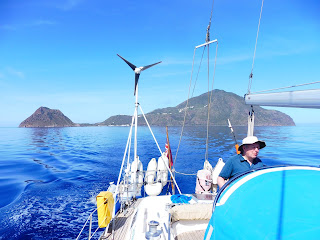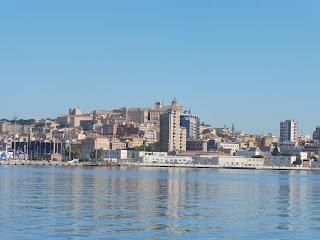From the Aolie Islands we sailed back to Milazzo, not the loveliest of towns, as the view from the promenade is dominated by an oil refinery, but still interesting with good beaches, some nice old buildings and a huge fortress on the hill above the town. Wendy and Jon, went shopping from the many old men with small fishing boats pulled up on the beach and came back with a rather boney but still very nice dinner.
From Milazzo we sailed along the north coast of Sicily and into the Straight of Messina, 2 miles wide at its narrowest point between Sicily and Italy. In ancient times the Straight had a fearsome reputation, complete with storms and a whirlpool, but it was very busy but otherwise benign when we passed through. The only excitement provided by a coastguard motorboat which stopped Cara Mara and informed us we couldn't anchor at Taormina our planned destination; as unknown to us, it was about to host the G7 conference.
We stayed down the coast at Riposta, (which Wendy had been looking forward to anyway, as it was reported to be the best marina in Sicily) and used the train to visit Taormina the following day. It is a hilltop town, very lovely, but full of shops aimed at the rich and famous, and packed with tourists, and for the G7 conference armed police and soldiers. Not really our scene.
Our next sail brought us to Syracuse, once the second most important Greek city, rivalling Athens for power and wealth. The oldest part of the city dating back to 700 BC, is on Ortiga, an island joined by a bridge, where you can tie up for 5 nights free of charge on the town quay. It was here that we said goodbye to Stuart an Jon and were really pleased to see Becky, who has joined us for a few day. Tomorrow we will hire a car to visit Etna and see more of Sicily, before she flies home on Sunday.
 |
| The fortress at Milazzo, overlooking oil refineries. |
 |
| We were followed through the Straights by this aircraft carrier and its escort of two frigates |
 |
| Taormina, you can usually anchor off the beach at the bottom of the hill and use a cable car to visit, but definitely not this day! |
 |
| The Greek theatre above Taormina being dressed up for G7 visitors. |
 |
| Etna from the marina at Riposta. |
 |
| Wendy with Archimedes, Syracuse most famous son. The genius was killed here when Romans took the city after a 2 year siege, ending the city's 200 year dominance of the Western Mediterranean. |
 |
| Its quite a surprise to enter the Duomo and see columns from the Templo di Atena, dating from 5th century BC. |
 |
| Wendy and Becky overlooking the Roman amphitheatre at Syracuse. |
 |
| Athens sent a huge fleet to attacked the upstarts at Syracuse. The sailors who survived apparently ended their days here in the cities stone mines. |

















































